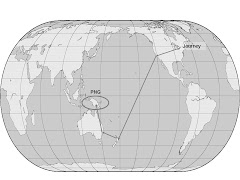(From Aretta Loving’s book, Slices of Life: From the Plate of a Bible Translator)
"I particularly enjoyed watching a woman, home early from her taro garden, prepare aboya. Sitting comfortably on the ground, she first peels taro tubers with a homemade knife: a razor-sharp piece of bamboo. Then with a thorny tree root she grates the taro. Water is added and brown hands became snow white as they work the taro-water mixture into a mush. The mush is spread onto a long, flattened bamboo tube, then bedecked with whatever delicacies she has on hand. Smoked rat, smoked frog or large, white witchetty grubs fresh from the foest are favorites. Finally, the woman chews up ginger rot and homemade salt, then spews the mixture onto the spread-out mush. The smashed bamboo is then rolled up and stuck inside a still larger bamboo tube. The long tube is laid over an open fire and gradually rotated and pushed through the fire. To make sure the tube stays on the fire long enough to cook the aboya, but not long enough to burn through the tube, is an art. And Awa women excel at this art!"
In 1959, Mrs. Loving and her husband Ed went to a remote village in PNG to live and work with the Awa people, to learn their language and to translate the Bible into it.
(Note: we won't be eating at that restaurant.)








